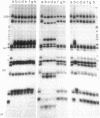Abstract
The penicillin-binding protein 2 genes (penA) of penicillin-resistant Neisseria meningitidis have a mosaic structure that has arisen by the introduction of regions from the penA genes of Neisseria flavescens or Neisseria cinerea. Chromosomal DNA from both N. cinerea and N. flavescens could transform a penicillin-susceptible isolate of N. meningitidis to increased resistance to penicillin. With N. flavescens DNA, transformation to resistance was accompanied by the introduction of the N. flavescens penA gene, providing a laboratory demonstration of the interspecies recombinational events that we believe underlie the development of penicillin resistance in many meningococci in nature. Surprisingly, with N. cinerea DNA, the penicillin-resistant transformants did not obtain the N. cinerea penA gene. However, the region of the penA gene derived from N. cinerea in N. meningitidis K196 contained an extra codon (Asp-345A) which was not found in any of the four N. cinerea isolates that we examined and which is known to result in a decrease in the affinity of PBP 2 in gonococci.
Full text
PDF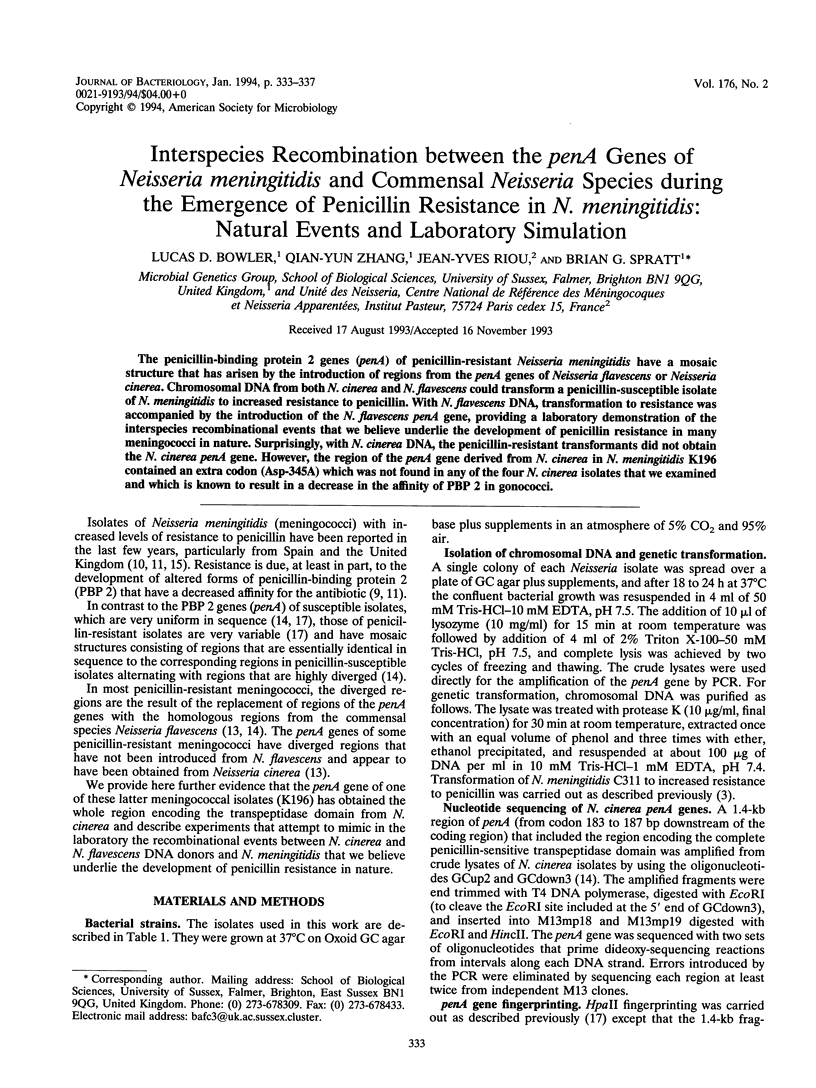
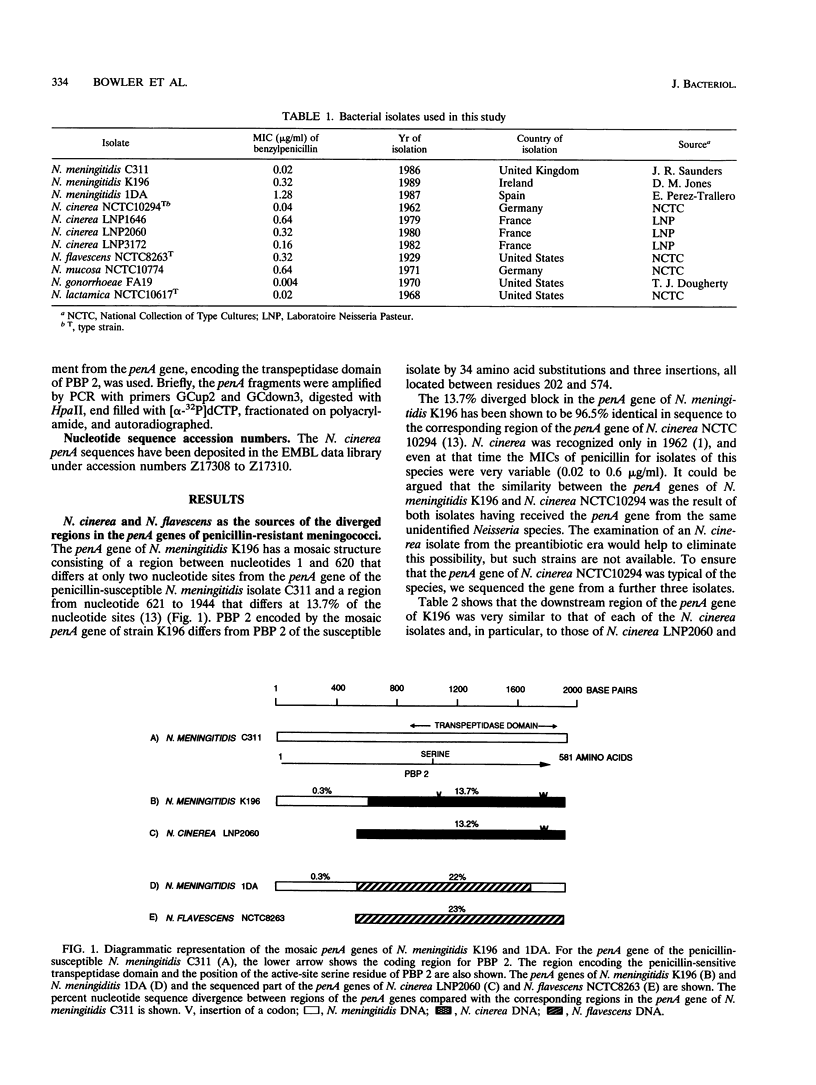
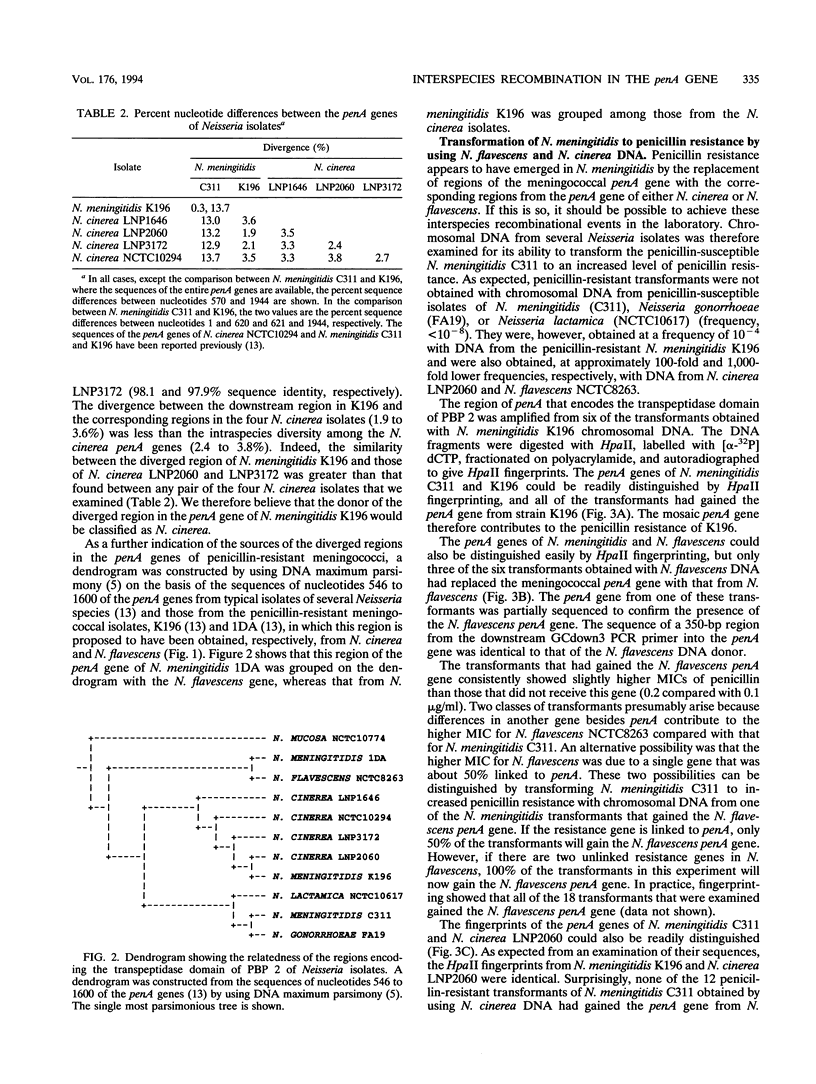
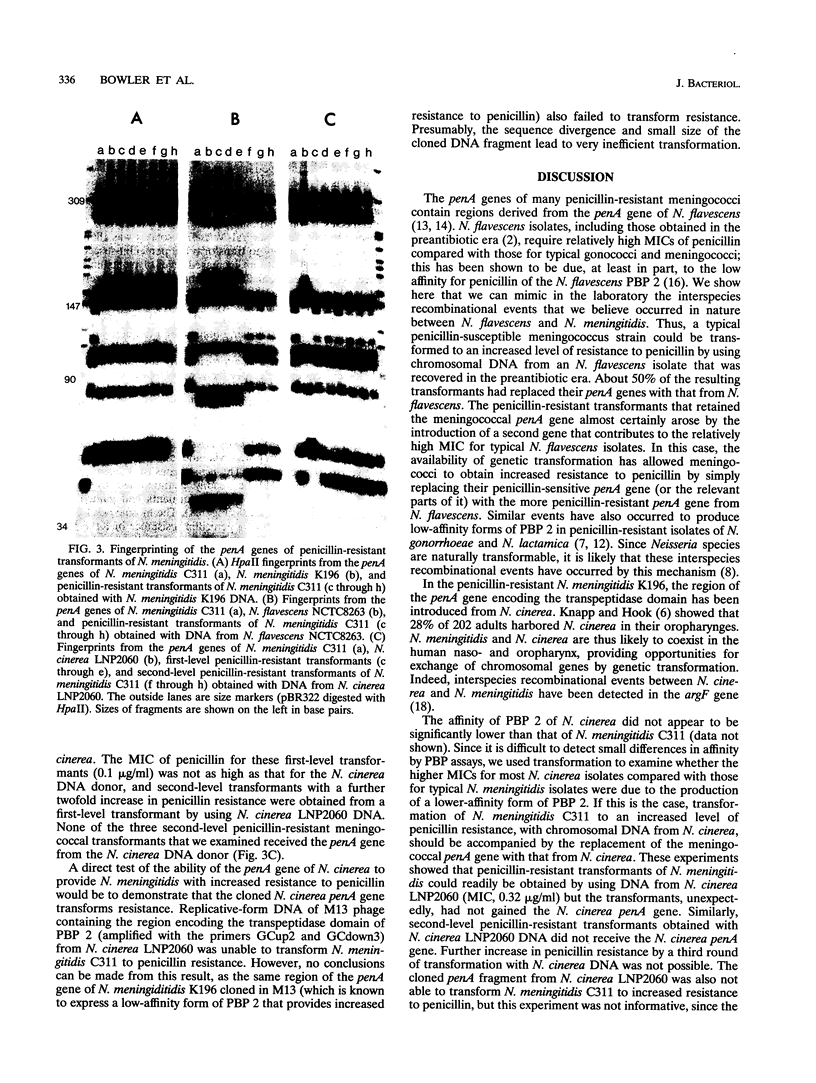
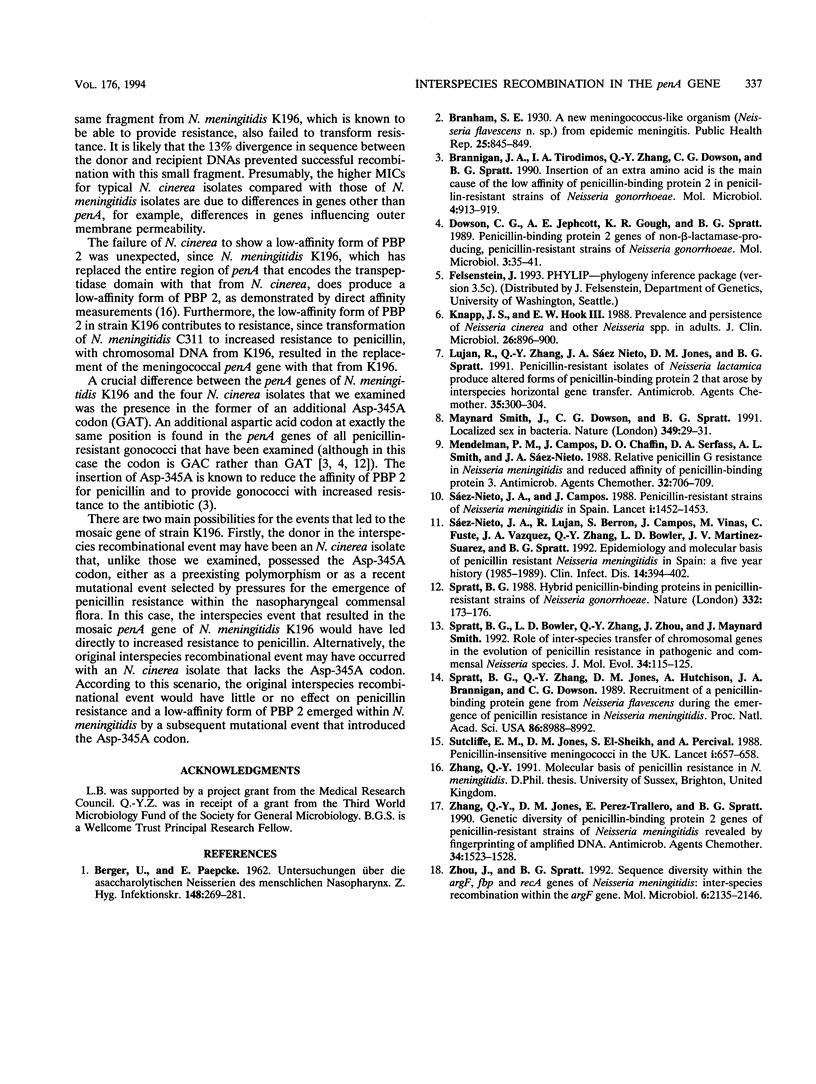
Images in this article
Selected References
These references are in PubMed. This may not be the complete list of references from this article.
- BERGER U., PAEPCKE E. [Studies on asaccharolytic Neisseria in the human nasopharynx]. Z Hyg Infektionskr. 1962;148:269–281. [PubMed] [Google Scholar]
- Brannigan J. A., Tirodimos I. A., Zhang Q. Y., Dowson C. G., Spratt B. G. Insertion of an extra amino acid is the main cause of the low affinity of penicillin-binding protein 2 in penicillin-resistant strains of Neisseria gonorrhoeae. Mol Microbiol. 1990 Jun;4(6):913–919. doi: 10.1111/j.1365-2958.1990.tb00664.x. [DOI] [PubMed] [Google Scholar]
- Dowson C. G., Jephcott A. E., Gough K. R., Spratt B. G. Penicillin-binding protein 2 genes of non-beta-lactamase-producing, penicillin-resistant strains of Neisseria gonorrhoeae. Mol Microbiol. 1989 Jan;3(1):35–41. doi: 10.1111/j.1365-2958.1989.tb00101.x. [DOI] [PubMed] [Google Scholar]
- Knapp J. S., Hook E. W., 3rd Prevalence and persistence of Neisseria cinerea and other Neisseria spp. in adults. J Clin Microbiol. 1988 May;26(5):896–900. doi: 10.1128/jcm.26.5.896-900.1988. [DOI] [PMC free article] [PubMed] [Google Scholar]
- Lujan R., Zhang Q. Y., Sáez Nieto J. A., Jones D. M., Spratt B. G. Penicillin-resistant isolates of Neisseria lactamica produce altered forms of penicillin-binding protein 2 that arose by interspecies horizontal gene transfer. Antimicrob Agents Chemother. 1991 Feb;35(2):300–304. doi: 10.1128/aac.35.2.300. [DOI] [PMC free article] [PubMed] [Google Scholar]
- Mendelman P. M., Campos J., Chaffin D. O., Serfass D. A., Smith A. L., Sáez-Nieto J. A. Relative penicillin G resistance in Neisseria meningitidis and reduced affinity of penicillin-binding protein 3. Antimicrob Agents Chemother. 1988 May;32(5):706–709. doi: 10.1128/aac.32.5.706. [DOI] [PMC free article] [PubMed] [Google Scholar]
- Penicillin-resistant strains of Neisseria meningitidis in Spain. Lancet. 1988 Jun 25;1(8600):1452–1453. [PubMed] [Google Scholar]
- Smith J. M., Dowson C. G., Spratt B. G. Localized sex in bacteria. Nature. 1991 Jan 3;349(6304):29–31. doi: 10.1038/349029a0. [DOI] [PubMed] [Google Scholar]
- Spratt B. G., Bowler L. D., Zhang Q. Y., Zhou J., Smith J. M. Role of interspecies transfer of chromosomal genes in the evolution of penicillin resistance in pathogenic and commensal Neisseria species. J Mol Evol. 1992 Feb;34(2):115–125. doi: 10.1007/BF00182388. [DOI] [PubMed] [Google Scholar]
- Spratt B. G. Hybrid penicillin-binding proteins in penicillin-resistant strains of Neisseria gonorrhoeae. Nature. 1988 Mar 10;332(6160):173–176. doi: 10.1038/332173a0. [DOI] [PubMed] [Google Scholar]
- Spratt B. G., Zhang Q. Y., Jones D. M., Hutchison A., Brannigan J. A., Dowson C. G. Recruitment of a penicillin-binding protein gene from Neisseria flavescens during the emergence of penicillin resistance in Neisseria meningitidis. Proc Natl Acad Sci U S A. 1989 Nov;86(22):8988–8992. doi: 10.1073/pnas.86.22.8988. [DOI] [PMC free article] [PubMed] [Google Scholar]
- Sutcliffe E. M., Jones D. M., el-Sheikh S., Percival A. Penicillin-insensitive meningococci in the UK. Lancet. 1988 Mar 19;1(8586):657–658. doi: 10.1016/s0140-6736(88)91469-9. [DOI] [PubMed] [Google Scholar]
- Sáez-Nieto J. A., Lujan R., Berrón S., Campos J., Viñas M., Fusté C., Vazquez J. A., Zhang Q. Y., Bowler L. D., Martinez-Suarez J. V. Epidemiology and molecular basis of penicillin-resistant Neisseria meningitidis in Spain: a 5-year history (1985-1989). Clin Infect Dis. 1992 Feb;14(2):394–402. doi: 10.1093/clinids/14.2.394. [DOI] [PubMed] [Google Scholar]
- Zhang Q. Y., Jones D. M., Sáez Nieto J. A., Pérez Trallero E., Spratt B. G. Genetic diversity of penicillin-binding protein 2 genes of penicillin-resistant strains of Neisseria meningitidis revealed by fingerprinting of amplified DNA. Antimicrob Agents Chemother. 1990 Aug;34(8):1523–1528. doi: 10.1128/aac.34.8.1523. [DOI] [PMC free article] [PubMed] [Google Scholar]
- Zhou J., Spratt B. G. Sequence diversity within the argF, fbp and recA genes of natural isolates of Neisseria meningitidis: interspecies recombination within the argF gene. Mol Microbiol. 1992 Aug;6(15):2135–2146. doi: 10.1111/j.1365-2958.1992.tb01387.x. [DOI] [PubMed] [Google Scholar]



